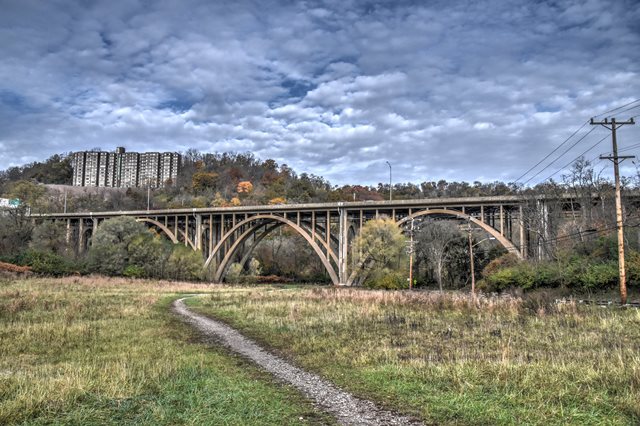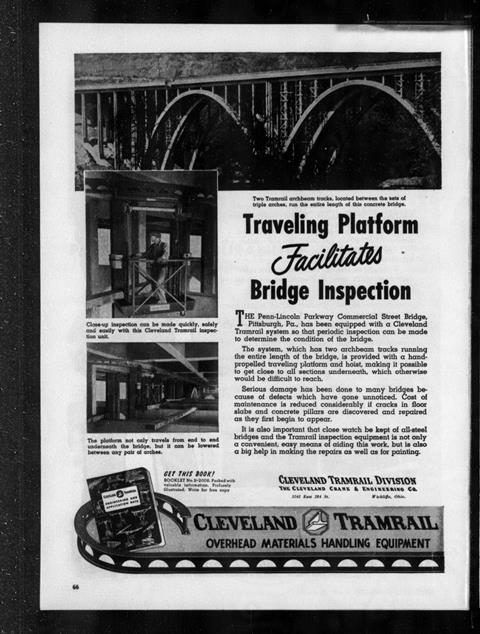We Recommend:
Bach Steel - Experts at historic truss bridge restoration.
BridgeHunter.com Phase 1 is released to the public! - Visit Now
Commercial Street Bridge

Primary Photographer(s): Nathan Holth
Bridge Documented: May 28, 2018 and November 4, 2019
I-376, US-22, US-30 (Penn Lincoln Parkway / Parkway East) Over 9 Mile Run and Commercial Street
Pittsburgh: Allegheny County, Pennsylvania: United States
1950 By Builder/Contractor: Dinardo Incorporated of Pittsburgh, Pennsylvania and Engineer/Design: Richardson, Gordon, and Associates of Pittsburgh, Pennsylvania (George S. Richardson)
2007
176.0 Feet (53.6 Meters)
863.0 Feet (263 Meters)
Not Available
3 Main Span(s) and 12 Approach Span(s)
1167

View Information About HSR Ratings
Bridge Documentation
This bridge's future is at risk!
Bridge Status: Slated for demolition and replacement by PennDOT!This large concrete arch bridge is configured as two parallel bridges, and is noted for its lack of bracing between arch ribs, giving the bridge an open appearance. The bridge is located a short distance east of the Squirrel Hill Tunnel. One unusual feature in the design of this bridge is that slag material was used in the concrete for this bridge, reportedly provided by the Duquesne Slag Company.
PennDOT provides the following details:
Each structure has 15 spans divided into 5 individual units consisting of 1 western T-Beam approach, 3 central open spandrel arches, and 1 eastern T-Beam approach. Each approach unit contains 6 spans. Each bridge has an overall length of 858’-9” with the following span arrangement:
• 6-span west approach T-Beam unit with 5 spans of 27’-6” and 1 span of 29’-0”
• Single span open spandrel arch of 176’-2”
• Single span open spandrel arch of 175’-3”
• Single span open spandrel arch of 174’-4”
• 6-span east approach T-Beam unit with 1 span of 29’-0” and 5 spans of 27’-6”
Each of the dual bridges has a cross section consisting of a 1’-9” fascia barrier, a 10’-0” outside shoulder, two 12’-0” travel lanes, a 0’-6” inside shoulder, and a 1’-6” median barrier. This results in an out-to-out dimension of 75’-6” for both structures.
View Archived National Bridge Inventory Report - Has Additional Details and Evaluation
View Historical Article About This Bridge

Above: 1952 advertisement featuring bridge.
Above: 1954 advertisement featuring bridge.
Above: 1957 advertisement featuring bridge.
Above: 1959 advertisement featuring bridge.
Information and Findings From Pennsylvania's Historic Bridge InventoryDiscussion of Bridge The 15 span, 863'-long bridge built in 1950 is composed of 3 open spandrel arch spans of 170'-long each, and 12 T beam approach spans of approximately 28'-long each. Each arch has 4 ribs with plain spandrel columns supporting floorbeams. There is a longitudinal joint at the center line due to the 71.5' width. The bridge has vertically scored pilasters at the piers, but otherwise architectural details are minimal. Safety shape parapets replaced original railings in 1981. The bridge is a later example of the open spandrel arch bridge technology that was developed during the first decade of the 20th century. It has no individually noteworthy or innovative details. It was chosen for this location based on economy of material, projected low long-term maintenance costs, and aesthetics. Its significance is in association and physical connection with the Penn Lincoln Parkway, a nationally outstanding post-WW II urban expressway project. The parkway and its associated structures are historically and technologically significant. Discussion of Surrounding Area The bridge carries a 4 lane median divided highway over a city street and a stream. The Penn Lincoln Parkway (1946-1960) is an important engineering achievement that is an outstanding example of post-WW II urban expressway planning and design. It required innovative engineering solutions, including the construction of more than 60 bridges, 2 major tunnels, complex interchanges, and the relocation of existing streets and rail lines. The parkway was the largest single project directed by the state highway department up to that time stretching over 19.5 miles in a general east-west direction from US 22 in Churchill to downtown and then west to SR 60 in Robinson Twp. It was built in stages over a period of 14 years mainly to spread out the huge expense. Bridge Considered Historic By Survey: Yes |
![]()
Photo Galleries and Videos: Commercial Street Bridge
Bridge Photo-Documentation
Original / Full Size PhotosA collection of overview and detail photos. This gallery offers photos in the highest available resolution and file size in a touch-friendly popup viewer.
Alternatively, Browse Without Using Viewer
![]()
Bridge Photo-Documentation
Mobile Optimized PhotosA collection of overview and detail photos. This gallery features data-friendly, fast-loading photos in a touch-friendly popup viewer.
Alternatively, Browse Without Using Viewer
![]()
Maps and Links: Commercial Street Bridge
Coordinates (Latitude, Longitude):
Search For Additional Bridge Listings:
Bridgehunter.com: View listed bridges within 0.5 miles (0.8 kilometers) of this bridge.
Bridgehunter.com: View listed bridges within 10 miles (16 kilometers) of this bridge.
Additional Maps:
Google Streetview (If Available)
GeoHack (Additional Links and Coordinates)
Apple Maps (Via DuckDuckGo Search)
Apple Maps (Apple devices only)
Android: Open Location In Your Map or GPS App
Flickr Gallery (Find Nearby Photos)
Wikimedia Commons (Find Nearby Photos)
Directions Via Sygic For Android
Directions Via Sygic For iOS and Android Dolphin Browser
USGS National Map (United States Only)
Historical USGS Topo Maps (United States Only)
Historic Aerials (United States Only)
CalTopo Maps (United States Only)






